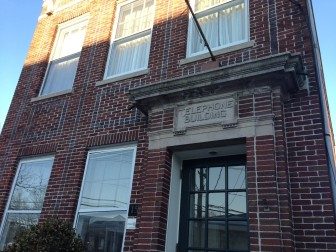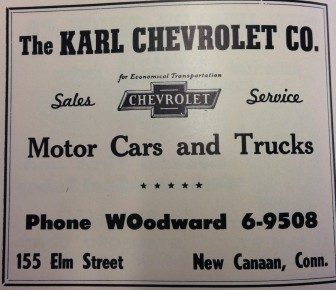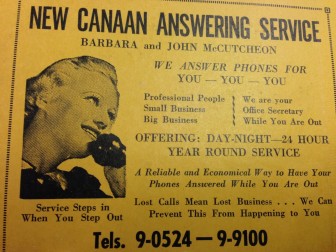‘New Canaan There & Then’ is sponsored by Brown Harris Stevens Realtors Bettina Hegel, Joanne Santulli, Dawn Sterner and Pam Stutz.
A fascinating article by Marshall H. Montgomery titled “It Deserves to be Celebrated or The First One Hundred Years of the telephone in New Canaan” appears in the 1981 Annual published by the New Canaan Historical Society. It provides a broad overview of the milestones in bringing telephone service to the town New Canaan. Here are some of the highlights:
The first telephone system began operating in New Haven, Connecticut in 1878, two years after Alexander Graham Bell patented the telephone. It had a switchboard and a directory printed upon a plain card. On May 21, 1881, Frances E. Weed, the founder of Weed & Duryea, announced in the Messenger that the Stamford & Norwalk Telephone Company was planning to run poles north of its present boundary lines. He urged residents to have the line extended into New Canaan. Telephone extension began on December 15, and by the 31st, there were phones installed at Hoyt Nurseries, H.B. Rogers clothing factory (88 Main Street), Johnson and Raymond Carriage Shop (the corner of East Avenue and Forest Street) and Franklin Stevens Livery on Elm Street. The Messenger got its phone a month later.

The Telephone Building on Main Street. Credit: Terry Dinan
By 1884, the cost of a call to Stamford or Norwalk was 10 cents. A call to anywhere else in Connecticut was a quarter.
In 1886, local businessmen applied for, and received, permission from the Borough Board for a “village system” – a system that needed no central office because each subscriber was his or her own operator. The village system was completed by July. The 28 subscribers included The Honorable Benjamin Mead, shoe factories Benedict & Co. (The Big Shop) and Fancher & Co., and J.F. Silliman. The village system lasted four years. Over the next two decades, the telephone system rapidly expanded throughout New Canaan. The phone lines extended out Smith Ridge Road to Michigan Avenue. Even farmers had telephones. George H. Stevens installed a phone at his bike shop so that motorists could call for help if they ran out of gas. (At the time, nine people in New Canaan had cars, out of a total of 2,155 in the state.)

Karl Chevrolet’s number is still technically “WO 6-9508.” You just have to dial it as “(203) 966-9508.”
By 1911, New Canaan ranked 31st in the state with 483 telephones. In 1914, operators were instructed to say “please” before ‘Number?” In 1915, Henry B. Thayer, who was president and board chair of AT&T and lived on Valley Road, made the first Connecticut to California toll call.
On February 28, 1954, the exchange Woodward 6 was chosen because it was distinctive, easy to remember, and difficult to confuse with other names. It lasted until 1963, when all digit dialing began. The “WO” was substituted for “96” because those numbers were in the same framework of the finger holes so New Canaan numbers all began with 966. 972 numbers were added in 1971.
 In Marshall’s article, he asks “What Next?” and goes on to discuss the computer revolution. Imagine “from our homes, we will order goods, make theater and travel reservations, take education courses, communicate with libraries, obtain weather forecasts and news summaries, and buy and sell stock.” It sounds quaint, but was also prescient. As New Canaan debates cell phone towers and high-speed Internet cables, it is interesting to reflect on how much has changed and to wonder what comes next.
In Marshall’s article, he asks “What Next?” and goes on to discuss the computer revolution. Imagine “from our homes, we will order goods, make theater and travel reservations, take education courses, communicate with libraries, obtain weather forecasts and news summaries, and buy and sell stock.” It sounds quaint, but was also prescient. As New Canaan debates cell phone towers and high-speed Internet cables, it is interesting to reflect on how much has changed and to wonder what comes next.
Love these little histories of local landmarks. Thank you Brown Harris Stevens agents for sponsoring these stories.
I remember when you just had to dial the last four numbers of an in town phone number to complete a call which went out sometimes in the 70s.
What I wish to note is how Charlie Morton auctioned the old telephone building on Main Street that sat vacant and was an expense to the Town. He wanted to do the prudent financial step for the Town which was to sell the building. This whole event brought a young Town merchant into the Town government process thinking it was a good investment. It is important to note that young man found an honest Town government in the process and although he did not win the bidding on the building he then went all in with his life investment of business and home into the Town of New Canaan. Good honest government has positive consequences.